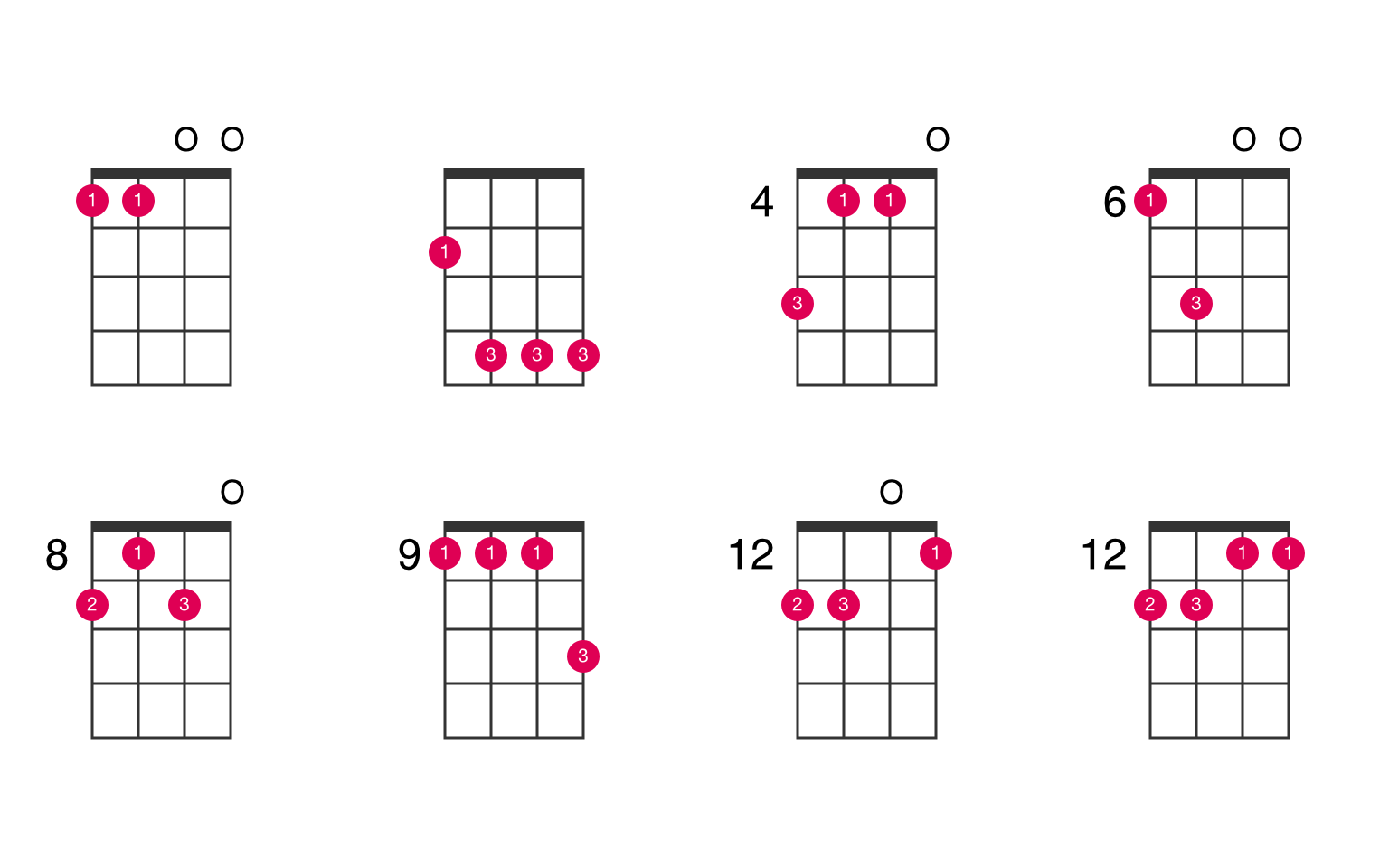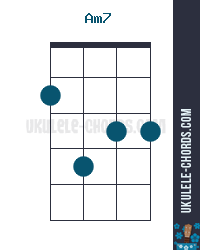The Am7 chord on the ukulele is played by placing fingers on specific strings and frets. It typically involves a finger on the second fret of the fourth string.
Mastering the Am7 chord on the ukulele can add a soulful touch to your playing repertoire. This chord is a minor seventh, blending a minor triad with a minor seventh, and it brings a rich, complex sound that’s often used in jazz, blues, and contemporary music.
The Am7 is easy for beginners to learn and essential for seasoned players. Strumming the Am7 chord involves a simple finger position that produces its distinctive mellow tone, making it a favorite for creating emotional depth in songs. Beginners will find it a comfortable chord to start with, and as players progress, the Am7 proves versatile across various musical genres. Understanding and incorporating the Am7 into your ukulele practice will not only enhance your chord vocabulary but also expand your musical expression.

Credit: ukelib.com
Introduction To Am7 Chord On Ukulele
The Am7 chord on the ukulele is a beautiful and versatile chord. Beginners and experienced players love its smooth, jazzy sound. Mastering this chord opens a world of musical possibilities.
The Basics Of Am7
To play the Am7 chord, also known as A minor 7, place your fingers on the ukulele fretboard. This chord requires no barred strings. It’s a comfortable shape for players at any level.
- Tune your ukulele: Standard tuning is GCEA.
- Finger placement: For Am7, you can actually leave all strings open.
- Strumming: Strum all four strings together.
Importance Of The Am7 In Music
The Am7 chord adds depth to songs and is vital for a variety of genres. It’s a subtle touch that can make a simple song sound sophisticated.
| Genre | Role of Am7 |
|---|---|
| Jazz | Core chord for harmonic progressions |
| Pop | Used for emotional sections |
| Rock | Brings a moody twist to riffs |
Across styles, Am7 can help a song transition smoothly between sections. It can also provide a song with a sense of completion when used at the end.
Fingering The Am7 Chord
One of the most serene chords on the ukulele is Am7. It carries a breezy and jazzy feel. Beginners love its minimal finger placement. Seasoned players appreciate the smooth transition it allows into other chords. Let’s explore how to master Am7.
Where To Place Your Fingers
Am7 is simple. You don’t need to place fingers all over the fretboard. It’s the magic of open strings at work. Follow these steps:
- Let all strings ring open.
- Do not press down on any fret.
- Strum lightly from the G string down to the A string.
There you go! You’ve played an Am7 chord. It’s that straightforward. No finger positioning required.
Common Mistakes And How To Avoid Them
Even with such a simple chord, it’s possible to miss the mark. Here’s how to avoid common errors:
| Mistake | How to Avoid |
|---|---|
| Strumming too hard | Use a gentle hand to keep the tone mellow |
| Accidentally fretting strings | Keep all fingers clear of the frets |
| Muffled sound | Check for and remove any obstructions |
Remember these tips, and playing Am7 will always sound perfect.
Sound And Texture Of Am7
The Am7 chord on the ukulele paints a rich tapestry of sound. It blends minor solemnity with a hint of sparkle. Known for its mellow and sophisticated vibe, Am7 finds its way into various musical genres. Let’s delve into what makes this chord so special in the world of music.
The Sonic Qualities Of Am7
The Am7 chord, or A minor seven, is composed of four notes. These are A, C, E, and G. The combination creates a smooth, gentle sound with depth. Striking the strings for an Am7 chord on the ukulele, the listener feels the soothing touch of the minor key complemented by the airy levity of the seventh note. It’s like a soft whisper in the ear, both calming and intriguing.
- A – the root note provides the foundation.
- C – the minor third adds a hint of sadness.
- E – the perfect fifth offers stability.
- G – the minor seventh gives the chord its airy quality.
The Am7 chord rings out with a unique texture that is both warm and inviting. Its versatility means it works well in relaxed verses or as a transition during a musical bridge.
Am7 In Different Musical Contexts
In various musical settings, Am7 adapts to reinforce the mood of a piece. In jazz, it can be the stepping stone to a complex chord progression. In pop, it often serves as a gentle backdrop for heartfelt lyrics. The chord’s adaptability can be heard in upbeat ukulele strumming patterns or slowed down for intimate ballads.
| Genre | Role of Am7 |
|---|---|
| Jazz | Complexity enhancer, mood setter |
| Pop | Emotional support, gentle backdrop |
| Ballads | Intimate texture, emotional depth |
| Folk | Storytelling aid, melodic warmth |
Whether strummed softly or plucked delicately, Am7 leaves a memorable impression. Its presence in a song can subtly shift the atmosphere, creating layers of sonic interest. From the lively lanes of Honolulu to the serene shores of Lake Como, the Am7 chord remains a beloved component of countless melodies and harmonies that stir the soul.

Credit: blog.ukelikethepros.com
Transitioning To Other Chords
Mastering the transition between chords on the ukulele creates a seamless and beautiful sound. The Am7 chord, known for its mellow tone, can enhance a song’s emotional depth. To enrich ukulele playing, learning how to move to and from Am7 smoothly is essential.
Chords That Pair Well With Am7
Certain chords naturally complement Am7, creating harmonies that resonate well. Consider these combinations:
- G major: Shares common notes for an easy switch.
- C major: Offers a bright contrast to Am7’s soft sound.
- F major: Adds warmth while maintaining the mellow mood.
- Dm7: Provides a smooth, jazzy transition.
- Em: Creates a haunting and emotive musical narrative.
- E7: Introduces tension that resolves back to Am7.
Practice Tips For Smooth Transitions
These strategies will help you switch chords with ease:
- Start slowly, focusing on accuracy over speed.
- Use a metronome to maintain a consistent pace.
- Repeat transitions in a loop to build muscle memory.
- Relax your fingers to avoid stiffness.
- Visualize the next chord shape before you move your fingers.
- Use minimal finger movement between chord changes.
With these tips, transitioning to and from Am7 on your ukulele will become a swift and fluid movement. Your practice will lead to effortless performances, making each chord change second nature.
Am7 In Popular Songs
The A minor 7 chord, often abbreviated as Am7, is a sweet and melancholic harmony that artists use to add depth to their songs. Blending the soulful A minor chord with a subtle G note creates Am7’s distinctive sound. This chord graces many popular tracks, allowing players to explore their musicality on the ukulele. Let’s dive into the tunes that feature the Am7 chord and learn how it contributes to their magic.
Tracks That Feature Am7
Countless musicians have embraced the Am7 chord in their compositions. Its versatility enables it to fit seamlessly into various genres and styles. Here are some examples:
- John Mayer – “Slow Dancing in a Burning Room”
- Norah Jones – “Don’t Know Why”
- Jack Johnson – “Banana Pancakes”
Learning From Song Examples
The best way to grasp the Am7 chord’s potential is by playing it in the context of a song. Try playing along with these popular tracks. Here are simple ways to learn:
- Listen to the song several times to get familiar with the rhythm and mood.
- Practice strumming the Am7 chord in isolation to perfect your finger placement.
- Play along with the track, focusing on transitioning smoothly to and from the Am7.
By analyzing and emulating how Am7 is used in popular music, you’ll quickly see how it contributes to a song’s emotional landscape.

Credit: ukulele-chords.com
Resources For Mastering Am7
The A minor 7 chord, or Am7, is a beautifully mellow chord on the ukulele. It’s an essential part of many songs. Your journey to master Am7 on the ukulele starts here. Below are trusted resources to guide you through learning this chord. Each resource suits different learning styles. They ensure you can strum the Am7 with confidence.
Best Online Tutorials For Am7
- Uke Like The Pros: Video lessons that detail finger placement for Am7.
- Ukulele Underground: Offers technique-enhancing tutorials.
- YouTube: Search for “Am7 ukulele tutorial” for varied instructional content.
Books And Guides For Further Study
For those who prefer physical study material, these books and guides are excellent:
- “Ukulele Method Book 1”: A thorough introduction to chords, including Am7.
- “The Daily Ukulele – 365 Songs”: Practice Am7 through song-playing.
- Local music shops: Often have a selection of ukulele guides.
Exploring these resources will help make the Am7 a natural part of your playing. Start practicing today!
How Can I Use Am7 Chord in Playing “Will You Be There” on the Ukulele?
To effectively use the Am7 chord while playing “Will You Be There” on the ukulele, focus on the song’s emotional transitions. The Am7 adds depth, enhancing the heartfelt lyrics. By integrating this chord into your practice, you can truly connect with the music as you learn to play will you be there.
Frequently Asked Questions Of What Is Am7 On Ukulele
What Is The Alternative To The Am7 Ukulele?
An alternative to the Am7 chord on the ukulele is the G major chord, often used due to similar tonal qualities.
What Does Am7 Mean?
Am7 stands for A minor 7th, a chord comprising the notes A, C, E, and G in music. It combines the A minor triad with a minor seventh interval.
What Is The Simple Am7 Chord?
The Am7 chord combines the notes A, C, E, and G. It’s a minor chord with a minor 7th, creating a smooth, jazzy sound.
What Is The Difference Between C6 And Am7 Ukulele?
The C6 chord on the ukulele is open, using all strings unpressed, creating a bright, full sound. Am7 differs as it adds a fretted note on the fourth string, giving it a more complex, jazzy tone.
Conclusion
Mastering the Am7 chord on the ukulele can enrich your playing repertoire significantly. With practice, this versatile chord will soon feel like second nature. Explore its harmonic potential and watch your ukulele skills flourish. Embrace the challenge; happy strumming!
